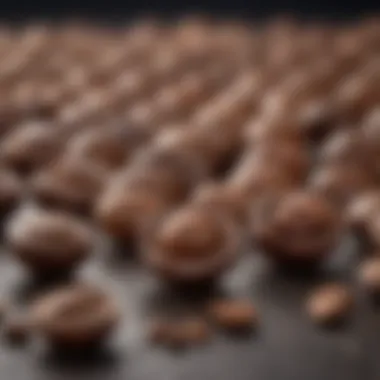Discover the Best Decaf Espresso Beans Today


Intro
In the realm of coffee, decaf espresso beans hold a significant place. They offer coffee lovers a chance to enjoy rich, flavorful espresso without the jitters associated with caffeine. This article aims to provide a detailed guide about the best decaf espresso beans available today.
Quality is often seen as compromised in decaffeinated options, but that is a misconception. There are brands that maintain an exceptional standard. We will explore various brands and evaluate their offerings. Understanding flavor profiles is vital when choosing espresso beans. We will discuss how roasting methods and sourcing can impact the taste and aroma of decaf espresso. Sustainability is also a growing concern. Both consumers and producers are leaning towards environmentally friendly practices. This guide will highlight brands that prioritize sustainable sourcing.
The journey through the world of decaf espresso beans will also include brewing methods. A well-brewed cup of decaf can be just as satisfying as its caffeinated counterpart. Whether you prefer an espresso machine, French press, or pour-over, methods can influence the final taste.
This guide is intended for both coffee enthusiasts and casual drinkers. The aim is to present information that helps in selecting the finest decaf espresso beans without sacrificing flavor. It is possible to enjoy a great cup of decaf without compromise.
Understanding Decaf Espresso
In a landscape where coffee consumption is deeply ingrained in daily life, the emergence of decaf espresso brings thoughtful consideration to taste and health. Understanding decaf espresso is pivotal, as it opens avenues for enjoyment without the accompanying buzz of caffeine. This section elucidates the essence of decaf espresso, specifically addressing its characteristics, the decaffeination journey, and the nuanced flavor profiles that affect the overall experience.
What is Decaf Espresso?
Decaf espresso refers to espresso that has significantly reduced caffeine content. Typically, decaffeinated coffee contains at least 97% less caffeine than its regular counterpart. This choice often caters to individuals who experience sensitivity to caffeine or those seeking to enjoy coffee without the potential side effects of heightened alertness. When prepared correctly, decaf espresso can offer a rich, complex flavor profile similar to regular espresso, making it a viable option for coffee lovers who prefer a milder beverage.
The Decaffeination Process
Decaffeination involves several methods designed to remove caffeine while preserving the flavor integrity of the beans. Understanding these processes is essential for discerning consumers looking for the best options.
Solvent-Based Methods
Solvent-based methods utilize chemical solvents like methylene chloride or ethyl acetate to extract caffeine from the beans. These solvents efficiently target caffeine molecules without significantly affecting other flavor components. This method is a popular choice due to its cost-effectiveness and efficiency.
Key characteristic: Efficiency in caffeine removal.
The unique feature of solvent-based processes is their ability to retain the coffee's natural flavors. However, some consumers express concern about chemical residues, although regulatory standards ensure safety levels in the final product.
Water Process
The water process, commonly referred to as the Swiss Water Process, employs pure water to decaffeinate beans. This method entails soaking the beans in water, allowing the caffeine to dissolve. The solution is then filtered to remove caffeine while preserving flavor components. The beans are subsequently reintroduced to the flavor-saturated water to restore some of the lost flavors.
Key characteristic: Chemical-free decaffeination.
The water process is lauded for its natural approach, making it appealing to health-conscious consumers. Nevertheless, it can be more expensive than solvent methods, which may be a consideration for some.
Carbon Dioxide Method
The carbon dioxide method utilizes pressurized carbon dioxide to selectively extract caffeine from coffee beans. Unlike other methods, CO2 targets caffeine specifically, leaving flavor compounds intact. This process allows for precise control over caffeine removal and quality retention.
Key characteristic: Precision in caffeine extraction.
A significant advantage of this method is its efficiency and ability to maintain flavors. It is often seen as a premium choice in decaffeination, attracting enthusiasts who prioritize quality, albeit at a higher price point.
Flavor Profiles of Decaf
The flavor profile of decaf espresso can vary significantly depending on the type of beans and the decaffeination method used. Understanding these profiles is vital for selecting beans that meet personal taste preferences.
Acidity
Acidity in coffee contributes to its brightness and overall flavor complexity. In decaf espresso, acidity levels can vary. A well-balanced acidity enhances the espresso's flavor, giving it liveliness despite reduced caffeine.
Key characteristic: Brightness in flavor.
Excessive acidity, however, may lead to a sour taste that detracts from the overall enjoyment. Therefore, knowing how each decaf type presents this quality can influence a buyer’s choice.
Body


The body of espresso refers to its weight and thickness on the palate. Decaf beans can vary in body, with some producing a rich, full-bodied espresso similar to their caffeine-rich counterparts. A robust body enhances the drinking experience, making it satisfying.
Key characteristic: Fullness in flavor and mouthfeel.
However, some decaffeination methods may lead to a thinner body, prompting tasters to consider the balance of flavors when selecting their beans.
Aftertaste
Aftertaste, or finish, refers to the lingering flavors left in the mouth after swallowing. A pleasant aftertaste can enhance the overall experience. Many decaf espressos aim for a clean finish that allows subtle flavor notes to shine through.
Key characteristic: The quality of lingering taste.
Some decaf options may leave a bitter or flat aftertaste, which can be undesirable. Understanding aftertaste helps guide choices in selecting decaf espresso beans that deliver a rewarding drink.
Why Choose Decaf Espresso Beans?
Decaffeinated espresso beans offer unique advantages for coffee lovers who wish to enjoy their favorite beverage without the stimulating effects of caffeine. Caffeine sensitivity and increasing concerns about anxiety make decaf a sensible choice for many. Additionally, it allows individuals to indulge in espresso at any time of day without disrupting their sleep patterns. This section outlines why choosing decaf espresso beans is a smart decision, enhancing the overall coffee experience.
Health Considerations
Caffeine Sensitivity
Caffeine sensitivity varies significantly among individuals. Some people experience heightened reactions even with small amounts of caffeine, leading to discomfort or jitters. For them, decaf serves as a gentle alternative. The key characteristic of caffeine sensitivity lies in how the body metabolizes this stimulant. Some may find they can enjoy all the rich flavors of espresso while avoiding unwanted side effects. This makes decaf espresso beans a viable option for anyone who wants to partake in coffee culture without the risk of experiencing anxiety or sleep disturbances.
The unique feature of caffeine sensitivity emphasizes the need for options in our beverage choices. By selecting decaffeinated espresso, one can indulge without compromise. It’s a beneficial choice for those who prioritize their well-being while still enjoying the sensory experience that coffee provides.
Reducing Anxiety
Anxiety is a significant concern for many people today. Certain individuals may find that caffeine exacerbates their feelings of anxiousness. Decaf espresso can help mitigate this issue. The primary characteristic here is that the absence of caffeine means fewer chances of increased heart rate or other symptoms associated with anxiety.
In this regard, reducing anxiety through the consumption of decaf offers a double benefit. It allows for enjoyment of espresso at any time while minimizing potential triggers. The tactful selection of decaf espresso helps individuals navigate their coffee habits without compromising their mental state. It serves as a useful option for those seeking to balance enjoyment with health considerations.
Enjoying Espresso Without Caffeine
For coffee enthusiasts, the joy of savoring a rich, flavorful espresso does not have to be overshadowed by the effects of caffeine. Decaf espresso offers a way to relish the warm, complex notes of coffee without the potential side effects of traditional espresso. This means you can enjoy a cup after dinner or during an afternoon break, maintaining a sense of indulgence at any hour.
Top Brands of Decaf Espresso Beans
When exploring the realm of decaf espresso, it's essential to identify the top brands that set themselves apart in terms of quality, flavor, and brewing versatility. These brands offer not just decaffeinated options but also uphold the standards that coffee enthusiasts expect from their espresso experience. Choosing the right decaf brand can enhance the overall enjoyment of espresso without the unwanted effects of caffeine, allowing for a satisfying coffee experience any time of the day.
Brand A: Overview and Features
Taste Profile
Brand A is known for its rich and aromatic decaf espresso beans. The key characteristic of its taste profile includes a balanced acidity paired with a smooth body. This combination results in a pleasant cup that appeals to both decaf lovers and those who usually prefer regular beans. A unique feature of Brand A's taste is its slight nutty undertone, which adds depth to the overall flavor. This characteristic makes it a popular choice among those looking for an enjoyable espresso experience without caffeine.
Recommended Brewing Methods
For the optimal brewing experience with Brand A, using an espresso machine is recommended. The key characteristic of this brewing method is that it brings out the full flavor profile of the beans, enhancing the overall tasting experience. The unique feature of using an espresso machine is that it allows for precise control over factors like pressure and temperature, which are critical in extracting the best flavors. However, it requires more skill and equipment than simpler methods, which may be a disadvantage for some.
Brand B: Overview and Features
Taste Profile
Brand B delivers a decaf espresso with distinct smoky notes and a fuller body. The caffeine removal process does not overshadow its robust flavors. Key characteristic here is the chocolatey nuance that gives the espresso a delightful richness. This aspect makes it an attractive choice for those who enjoy bold coffee flavors. A unique feature is the slight sweetness that emerges from the beans, which can often lead to a harmonious balance in a cappuccino or latte.
Recommended Brewing Methods
Pour-over methods are ideal for brewing Brand B. This technique allows the user to control the water flow and extraction time carefully. The key characteristic of pour-over brewing is its ability to highlight the intricate flavors of the coffee. A unique feature of this method is the use of a coffee cone, which can enhance the final taste even more. On the downside, it demands more time and attention compared to an espresso machine.
Brand C: Overview and Features


Taste Profile
Brand C provides a unique decaf espresso experience characterized by a bright acidity and floral notes. This key characteristic attracts those who prefer lighter, more delicate flavors in their coffee. A notable feature of Brand C's offering is its ability to maintain a clear flavor profile without bitterness, allowing for a refreshing cup. This makes it an excellent choice for those seeking something different from traditional deep, dark espressos.
Recommended Brewing Methods
For Brand C, the AeroPress tends to be an ideal choice for brewing. The key characteristic of this method is the pressure applied during extraction, which can produce a flavor-packed cup in less time. A unique feature of the AeroPress is its portability, allowing coffee lovers to brew high-quality espresso anywhere. Some might find it less complex compared to traditional machines, but it may not deliver the same level of crema that espresso machines can provide.
Evaluating Decaf Espresso Quality
Quality in decaf espresso is vital for ensuring an enjoyable drinking experience. Many people misunderstand decaffeination as an inferior process. However, understanding how to evaluate decaf espresso ensures that one can make informed choices. Consumers should not overlook the importance of freshness and aroma in decaf coffee, as these aspects greatly influence flavor. Furthermore, the right evaluation techniques can lead to discovering exceptional beans that deliver satisfying results.
Selecting Quality Beans
Visual Inspection
Visual inspection is a fundamental step in assessing the quality of decaf espresso beans. This involves examining the size, shape, and color of the beans. Quality beans tend to be uniform in color and have a consistent size. Any noticeable defects, such as cracks or discoloration, can signal problems in the roasting or decaffeination process.
One key characteristic of visual inspection is the ability to identify freshness. Fresh beans often appear glossy due to the natural oils present. Glossier beans indicate that they have been recently roasted and are likely to produce a richer flavor. For this article, visual inspection is a beneficial choice as it serves as the first line of defense in detecting quality issues.
However, visual inspection has limitations. It does not fully capture the aromas and subtle flavors present in the beans. Thus, while this method is useful, it should not be the only evaluation technique.
Smell Test
The smell test is another important method for evaluating decaf espresso beans. Aroma plays a significant role in how coffee is perceived. When evaluating decaf beans, inhaling their scent can reveal much about their quality. A pleasing aroma often suggests a higher-quality bean that will deliver a better flavor experience.
A key characteristic of the smell test is its immediacy. Unlike taste, scent can be evaluated almost instantly. This is particularly advantageous for individuals looking to quickly evaluate a batch of beans. Furthermore, the unique feature of the smell test is that it can highlight flaws that may not be visible. Beans that have a flat or musty aroma may be stale or improperly stored.
Nonetheless, the smell test can have disadvantages. It may sometimes be influenced by surrounding scents or poor packaging. Therefore, it is best used in conjunction with other evaluation methods.
Grind Size for Espresso
Grind size significantly impacts the extraction process when making espresso. Proper grind size ensures that the flavors are released effectively during brewing. For decaf espresso, a fine grind is usually recommended. This allows for optimal extraction of flavors without over-extracting, which can lead to bitterness.
Moreover, the grind size must match the brewing method used. If the grind is too coarse, the espresso can turn out weak and lacking in richness. Conversely, if the grind is too fine, it can lead to over-extraction and unwanted bitterness. Therefore, understanding how grind size affects brew quality is crucial for anyone looking to enjoy decaf espresso.
"Decaf espresso may lack caffeine, but its flavor potential should not be underestimated."
Brewing Techniques for Decaf Espresso
Brewing decaf espresso is not just about the beans; it involves understanding how to best prepare the coffee to highlight its unique flavors. The right brewing technique can significantly influence the taste and overall experience. Paying attention to variables such as temperature, extraction time, and the method used can unlock the hidden potential of decaf espresso beans, delivering a satisfying cup without the jitters of caffeine.
Using an Espresso Machine
Using an espresso machine offers precision necessary for brewing decaf espresso effectively. Maintaining consistent temperature and pressure is crucial to achieving optimal extraction.
Temperature Considerations
Temperature is an essential factor in brewing espresso. The ideal temperature for brewing decaf espresso typically ranges between 195°F and 205°F (90°C to 96°C). Using water that is too hot can lead to over-extraction, resulting in bitter flavors. On the other hand, too low temperature can cause under-extraction, leaving the coffee bland.
A key characteristic of temperature control is its ability to bring out the beans' flavor profile. Maintaining the right temperature is a beneficial choice because it can enhance sweetness and acidity in decaf espresso. The unique feature of temperature is its direct impact on solubility, which affects how well the flavors are extracted from the coffee grounds. However, managing temperature can be challenging, as the brewing environment can introduce fluctuations.
Extraction Time
Extraction time is another crucial aspect. For espresso, the ideal extraction time is generally between 25 to 30 seconds. This time frame allows for the proper balance of flavors to be extracted. A key characteristic of extraction time is that it influences the body and richness of the espresso. A longer extraction often results in more robust flavors, whereas a shorter one may yield a milder profile.
The unique feature of extraction time is that small adjustments can lead to noticeable changes in flavor. By controlling for time, you can enhance desirable traits in decaf espresso, thereby making it a popular choice for enthusiasts. However, careful monitoring is necessary, as an over-extracted shot can taste harsh, while under-extraction might yield a weak cup.
Alternative Brewing Methods
Alternative brewing methods can also be utilized to prepare decaf espresso, offering flexibility to coffee lovers. Such methods often allow for different flavor extractions and can cater to various preferences.


French Press
The French Press is a popular method for brewing decaf espresso-style coffee. This method involves steeping the coffee grounds in boiling water before pressing down a metal or plastic plunger. The French Press allows for maximum extraction of oils and flavors, creating a rich and full-bodied cup of coffee. A notable characteristic of this technique is its simple process.
It is beneficial because it does not require special equipment, making it accessible for all coffee enthusiasts. The unique feature of the French Press is the sediment it retains, leading to a more intense flavor experience. However, some may find the residue adds a gritty texture, which could be unappealing to certain drinkers.
AeroPress
The AeroPress is another effective brewing tool for decaf espresso. It uses air pressure to push hot water through coffee grounds, resulting in a quick extraction. This method is favored for its versatility and ease of use. A key characteristic of the AeroPress is its ability to brew under various conditions; it can make coffee stronger or milder depending on the user’s preference.
The AeroPress is beneficial due to its portability, making it suitable for travel. It allows for multiple brewing styles. Its unique feature includes the ability to create espresso-like coffee without requiring an espresso machine. However, the extraction process is somewhat shorter than traditional methods, which may not suit those looking for a more traditional espresso experience.
Exploring different brewing techniques can bring new life to decaf espresso. Each method highlights different aspects of the beans, allowing for a unique experience in every cup.
Storing Decaf Espresso Beans
Storing decaf espresso beans correctly is pivotal for maintaining their flavor and freshness. Many coffee enthusiasts overlook storage methods, leading to a diminished coffee experience. Proper storage practices protect the beans from factors that can alter their taste profile, such as moisture, light, and air. The right techniques can significantly enhance the quality of your decaf espresso, ensuring a satisfying cup every time.
Best Storage Practices
To maximize the quality of your decaf espresso beans, consider the following storage practices:
- Airtight Containers: Use containers specifically designed to keep air out. Glass or ceramic jars with a tight seal work well.
- Cool, Dark Places: Store beans in a location that is away from sunlight and heat sources. A cupboard or pantry is generally ideal.
- Avoid Refrigeration: While some may think refrigeration keeps beans fresh, it can introduce moisture and unwanted odors, negatively impacting flavor.
- Buy in Small Quantities: Purchase only as much as you can use within a week or two. This reduces the likelihood of stale beans.
By following these storage guidelines, you retain the original qualities of decaf espresso beans, which helps in creating the best brew.
Shelf Life Considerations
Decaf espresso beans do have a shelf life. Typically, roasted coffee lasts about two weeks after opening if stored correctly.
- Check Roast Dates: Always look for the roast date on the packaging and aim to consume within a month of that date for optimal taste.
- Signs of Staleness: If beans appear dull instead of shiny, or they emit little to no coffee aroma, it's likely time to discard them.
- Storage Duration: Unopened, sealed beans may last up to six months if stored properly, but opened beans generally should be consumed within two weeks for the best flavor.
Sustainability in Decaf Coffee Production
Sustainability is a crucial topic in the coffee industry, including decaffeinated coffee. With a growing concern about environmental degradation and ethical practices, understanding sustainability within decaf coffee production can help consumers make informed choices. Sustainable practices include ethical sourcing, environmental protection, and community support.
By prioritizing sustainable decaf espresso beans, consumers contribute to a better future for the planet and the communities that grow these beans. Moreover, sustainable production often leads to higher quality coffee, as the care for the environment and labor results in better farming practices and healthier coffee plants.
Ethical Sourcing Practices
Ethical sourcing in decaf coffee production means that the beans are purchased from suppliers who adhere to fair labor practices. Many roasters now seek certifications, such as Fair Trade or Rainforest Alliance, which guarantees that farmers receive fair wages and are treated with respect.
These practices enhance the livlihood of coffee growers and keeper sustainable agriculture. By paying farmers fairly, they can invest in better farming methods and ensure their families have access to education and healthcare. As consumers, supporting brands that practice ethical sourcing allows individuals to contribute to a just coffee supply chain.
Environmental Impact
The environmental impact of decaf coffee production is significant. The choice of decaffeination process plays a role in this. Some methods use harmful chemicals, which can lead to soil and water pollution. For instance, solvent-based methods, while effective at removing caffeine, pose risks to ecosystems if not managed properly.
In contrast, processes like the water method or carbon dioxide method are considered more environmentally friendly. These methods reduce the amount of harmful emissions and use natural resources more efficiently. Additionally, sustainable farming practices promote biodiversity, soil health, and water conservation. By choosing decaf espresso beans from environmentally responsible sources, consumers can help mitigate environmental degradation and support a more sustainable coffee industry.
"Choosing sustainably sourced and environmentally friendly decaf coffee not only enhances flavors but also supports the well-being of our planet."
In summary, sustainability in decaf coffee production encompasses ethical sourcing and environmental stewardship. Consumers' choices can drive change in the coffee industry, promoting practices that respect both people and the planet.
Finale: Selecting the Best Decaf Espresso Beans
Selecting the right decaf espresso beans is a crucial step for those who want to enjoy the rich flavors of espresso without the effects of caffeine. This guide has provided extensive insights into various aspects of decaffeinated coffee, from understanding its unique qualities and the decaffeination process to brewing techniques and storage practices.
First, the flavor profile of decaf beans is essential. Those who choose decaf should not have to sacrifice taste. Every bean possesses distinctive attributes such as acidity and body, impacting the final cup. An informed choice can lead to rich flavors and a satisfying experience.
Furthermore, understanding the importance of sustainable sourcing cannot be ignored. Ethical practices in coffee production ensure that the taste quality is maintained while supporting the environment and local communities. Choosing brands committed to sustainability can make a significant impact.
When considering specific brands, factors like recommended brewing methods, and taste profiles must guide your selection. Whether you prefer a smooth, chocolatey blend or a nutty, bright flavor, understanding your options allows for a more enjoyable experience.
Additionally, paying attention to storage practices and shelf life enhances the longevity of the beans you purchase. Proper conditions can preserve flavors and aromas, leading to a better cup of coffee every time it is brewed.
"The choice of decaf espresso beans can define your coffee experience. Choose wisely."







